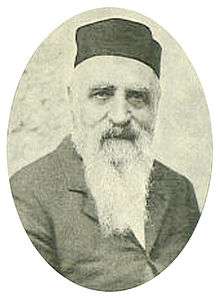Charles Dadant
Charles Dadant (20 May 1817 – 26 July 1902) was a French-American beekeeper. Along with Petro Prokopovych, Dadant is considered one of the founding fathers of modern beekeeping.
Charles Dadant | |
|---|---|
 Charles Dadant | |
| Born | 20 May 1817 |
| Died | 26 July 1902 |
| Other names | French American |
| Occupation | Beekeeper |
| Known for | Founder of modern beekeeping |
Biography
Dadant was born in Vaux-sous-Aubigny, in Haute-Marne, in the Champagne-Ardenne region of France.
In 1863, at age forty-six, he moved to America, with dreams of starting a vineyard. Dadant purchased land on the rolling tallgrass prairie in Hamilton, western Illinois, where he built a simple log house.
After paying for his family to come to America from France and buying a farm, he was penniless. He did not know a word of English, but he was determined to succeed in his new country. When his dreams of being a vintner were not fulfilled, he turned to beekeeping, a hobby he had learned in France.
Dadant learned English by subscribing to the New York Tribune. While working as a traveling salesman in France he educated himself. As his horse would plod along, Dadant would read the works of the French biologist Jean-Baptiste Lamarck and the theories of the socialist Charles Fourier.
He renounced the Catholic Church and became a socialist. When he moved to America he modeled his beekeeping business on socialist principles by working alongside his employees.
By the end of the American Civil War he had nine colonies of honeybees, and traveled with his young son across the Mississippi River to sell honey and beeswax in a neighboring town. His interest in making quality candles grew from his love and knowledge of beekeeping.
He invented the Dadant bee-hive, which has a 42 × 26.6 cm frame and founded in Hamilton one of the first factory of bee-keeping tools. The Dadant factory is still owned by the Dadant family.
He contributed articles on beekeeping to numerous bee journals, both American and European. Dadant acquired The American Bee Journal and Dadant and Sons have published it since. He translated Langstroth's The Hive and the Honey-Bee into French so the rest of the world would learn of Langstroth's contributions to beekeeping.
He strived to import Italian bees into the United States and, according to ABC in Bee Culture 1890, he succeeded by shipping 250 queen bees to the United States in 1874. He was not the first to bring Italian queens into the United States, selling for up to half the price ($12) asked by his competitors.
He was always seeking a better way to keep bees. Just as he had begun with the old European "eke" he quickly abandoned that kind of beekeeping for the modern Langstroth hive concept. Bee hives have often been designed and built without regard for the needs and habits of the honey bee colony. Probably the best design for a colony was the large hive developed by Charles Dadant. It provided a large, deep brood chamber with plenty of room in which the queen could lay, and shallower supers for honey storage. However, the price and promotion of smaller hives offered for sale during the period from about 1885 to 1900 made them more popular.
Charles Dadant died in Hamilton in 1902.
He had one son, Camille Pierre Dadant (1851-1938).
In 1978, The Center for Icarian Studies (Western Illinois University) received from the Dadant family a collection of papers consisting of biographical information, Life and Writings of Charles Dadant by C.P. Dadant and The Life of C.P. Dadant, by M.G. Dadant.